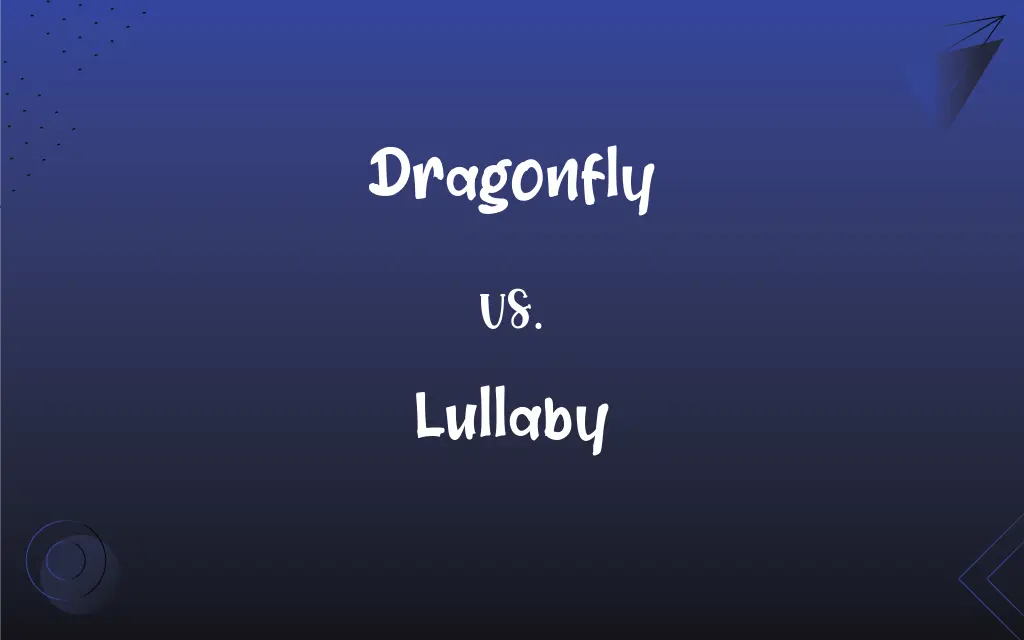Dragonfly vs. Lullaby: What's the Difference?
By Harlon Moss & Janet White || Updated on March 4, 2024
Dragonflies are winged insects known for their long bodies and agile flight, often found near water. Lullabies are soothing songs or melodies played or sung to calm children and help them fall asleep.

Key Differences
Dragonflies are insects belonging to the order Odonata, characterized by their elongated bodies, two pairs of strong, transparent wings, and large, multifaceted eyes. They are predators, feeding on smaller insects, and are admired for their flying abilities, able to hover and even fly backward. Lullabies, on the other hand, are gentle, soothing songs or melodies designed to comfort or calm, especially to aid children in falling asleep. Lullabies are found in nearly every culture around the globe and often carry messages of love, comfort, and protection.
Dragonflies are often associated with water, as their larvae, known as nymphs, live in aquatic environments before undergoing metamorphosis into adults. They play a significant role in various ecosystems, controlling pest populations and serving as indicators of environmental health. Lullabies can be simple or complex, featuring lyrics that are sometimes nonsensical or repetitive, focusing on the melodic quality to soothe the listener. Beyond their immediate purpose of helping children sleep, lullabies often strengthen bonds between caregivers and children and are part of cultural heritage and tradition.
While dragonflies and lullabies occupy entirely different categories—one being an insect and the other a form of music they both hold a special place in human perception. Dragonflies symbolize change, adaptability, and the wonders of nature, often inspiring art and poetry. Lullabies, through their emotional and cultural depth, play a critical role in human development and cultural identity, symbolizing care, comfort, and the universal practice of nurturing the young.
Comparison Chart
Nature
Insect belonging to the order Odonata.
A soothing song or melody to calm children.
Characteristics
Elongated body, large eyes, and transparent wings.
Gentle, soothing melodies with comforting lyrics.
ADVERTISEMENT
Habitat
Commonly found near water.
Exists in various cultures worldwide.
Function
Predatory role in ecosystems; indicator of environmental health.
Aids in soothing and putting children to sleep.
Cultural Significance
Often symbolize change and adaptability.
Symbolize care, comfort, and cultural heritage.
Usage
Observed in nature and represented in art and literature.
Sung or played to comfort, especially for children.
Dragonfly and Lullaby Definitions
Dragonfly
A fast-flying insect known for its agile flight.
The dragonfly darted over the pond, catching mosquitoes.
ADVERTISEMENT
Lullaby
A soothing song to help children sleep.
She sang a lullaby to her baby every night.
Dragonfly
Symbol of change in various cultures.
In some cultures, a dragonfly sighting is considered a sign of change or new beginnings.
Lullaby
Features gentle, calming melodies.
The lullaby's melody was soft and rhythmic, perfect for bedtime.
Dragonfly
Predator of smaller insects.
Dragonflies help control the mosquito population.
Lullaby
Often involves repetitive, simple lyrics.
The lullaby repeated the line sleep, baby, sleep throughout the song.
Dragonfly
Aquatic larvae stage.
Dragonfly nymphs live in water before emerging as adults.
Lullaby
Can be instrumental or vocal.
The music box played a lullaby to soothe the crying child.
Dragonfly
Indicator of environmental health.
A healthy dragonfly population often indicates clean water.
Lullaby
Part of cultural traditions worldwide.
Lullabies are a universal way to express love and comfort to children.
Dragonfly
Any of numerous predatory insects of the order Odonata, having large eyes, a long slender body, and two pairs of transparent veined wings, especially those of the order Anisoptera, which hold the wings outstretched when at rest, as distinguished from the damselflies. Also called regionally darner, darning needle, devil's darning needle, mosquito fly, mosquito hawk, needle, skeeter hawk, snake doctor, snake feeder, spindle.
Lullaby
A soothing song with which to lull a child to sleep.
Dragonfly
An insect of the suborder Epiprocta or, more strictly, the infraorder Anisoptera, having four long transparent wings held perpendicular to a long body when perched.
Lullaby
To quiet with or as if with a lullaby.
Dragonfly
Slender-bodied non-stinging insect having iridescent wings that are outspread at rest; adults and nymphs feed on mosquitoes etc.
Lullaby
A cradlesong, a soothing song to calm children or lull them to sleep.
Sing a lullaby
Lullaby
(transitive) To sing a lullaby to.
Lullaby
A song to quiet babes or lull them to sleep; that which quiets.
Lullaby
Hence: Good night; good-by.
Lullaby
A quiet song intended to lull a child to sleep
Lullaby
A quiet song that lulls a child to sleep
FAQs
Are lullabies used in any other context besides bedtime?
While primarily used for bedtime, lullabies can also comfort children during times of distress or simply as a form of gentle, loving communication.
How do dragonflies differ from other flying insects?
Dragonflies are distinguished by their large eyes, two pairs of strong wings, and their ability to fly in any direction, including backward.
How have lullabies evolved over time?
Lullabies have adapted to reflect cultural changes, but their core purpose of soothing and bonding has remained constant across generations.
Do all cultures have their own lullabies?
Yes, virtually every culture has its own set of lullabies, reflecting universal themes of love, comfort, and protection, despite variations in language and melody.
Why are lullabies significant in child development?
Lullabies soothe children, aiding in sleep, and foster emotional bonds between caregivers and children, contributing to emotional and cognitive development.
Can lullabies have an impact on adult sleep patterns?
Yes, the soothing melodies and rhythms of lullabies can help adults relax and improve the quality of their sleep, similar to their effect on children.
Can adults find comfort in lullabies?
Yes, the calming effect of lullabies can also soothe adults, providing relaxation and reducing stress.
What makes dragonflies an important part of ecosystems?
Dragonflies control pest populations and their presence indicates a healthy environment, especially clean water sources.
How do dragonflies help control mosquito populations?
Dragonflies are natural predators of mosquitoes, both in their aquatic larval stage, where they consume mosquito larvae, and as adults, catching and eating adult mosquitoes, thereby helping to control mosquito populations and reduce the spread of mosquito-borne diseases.
Can lullabies from one culture be effective in another?
Yes, the soothing effect of lullabies transcends cultural and linguistic barriers. The melody and tone of the music are often more influential in providing comfort than the specific words or language, making lullabies universally effective.
Is there a therapeutic use of lullabies in modern healthcare?
Lullabies are used in music therapy to soothe patients, reduce anxiety, and facilitate healing and relaxation in medical settings, including hospitals, particularly in neonatal and pediatric care units.
What role do dragonflies play in indicating environmental health?
Dragonflies thrive in clean water environments; a diverse and abundant dragonfly population often signals good water quality and a healthy ecosystem.
What is the significance of the dragonfly's life cycle?
The dragonfly's life cycle, which includes a dramatic transformation from nymph to adult, symbolizes change and the ability to adapt and thrive.
Do dragonflies migrate?
Yes, some species of dragonflies do migrate. For instance, the globe skimmer (Pantala flavescens) is known for its long-distance migrations across oceans and continents, similar to some bird species.
What challenges do dragonflies face in their habitats?
Dragonflies face several challenges, including habitat loss due to urbanization and agriculture, pollution of water bodies, climate change affecting water temperatures and levels, and the introduction of invasive species that compete for resources.
Have modern lullabies changed in content or style from traditional ones?
While the core purpose of lullabies remains the same, modern lullabies may incorporate contemporary musical styles and themes that reflect current societal values and technological advancements. However, many traditional lullabies continue to be popular due to their timeless appeal.
Are there specific types of music or instruments typically used in lullabies?
Lullabies often feature soft, melodious music, with common instruments including the piano, harp, and guitar. The key is the gentle and soothing sound, regardless of the specific instrument.
How are lullabies shared or passed down through generations?
Lullabies are often passed down orally from parents to children, with many also being preserved and shared through recordings, books, and online platforms. This tradition helps maintain cultural heritage and provides a link between generations.
What is the difference between a dragonfly and a damselfly?
Dragonflies and damselflies are both part of the Odonata order but differ in several ways. Dragonflies have broader bodies, eyes that touch or nearly touch at the top of the head, and they hold their wings open horizontally when at rest. Damselflies have slimmer bodies, eyes that are clearly separated, and they hold their wings together above their bodies when at rest.
How can observing dragonflies contribute to environmental science?
Observing dragonflies can provide valuable data on changes in habitat quality, climate change impacts, and biodiversity. Their sensitivity to environmental changes makes them excellent indicators for ecological monitoring and conservation efforts.
About Author
Written by
Harlon MossHarlon is a seasoned quality moderator and accomplished content writer for Difference Wiki. An alumnus of the prestigious University of California, he earned his degree in Computer Science. Leveraging his academic background, Harlon brings a meticulous and informed perspective to his work, ensuring content accuracy and excellence.
Co-written by
Janet WhiteJanet White has been an esteemed writer and blogger for Difference Wiki. Holding a Master's degree in Science and Medical Journalism from the prestigious Boston University, she has consistently demonstrated her expertise and passion for her field. When she's not immersed in her work, Janet relishes her time exercising, delving into a good book, and cherishing moments with friends and family.































































